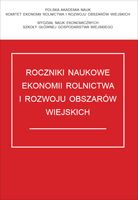Main Article Content
Article Details
Aulakh Milkha, Joginder Manchanda, Ashok Garg, Shrvan Kumar, Gerd Dercon, Minh-Long Nguyen, 2012: Crop production and nutrient use efficiency of conservation agriculture for soybean-wheat rotation in the Indo-Gangetic Plains of Northwestern India. "Soil and Tillage Research", vol. 120, 50-60. (Crossref)
Badia-Melis Ricardo, Puneet Mishra, Luis Ruiz-García, 2015: Food traceability: New trends and recent advances. A review. "Food Control", vol. 57, 393-401. (Crossref)
Changkid Nantawan, 2013: The Factors Production Use Efficiency in the Integrated Farming in Suratthani Province, Southern Thailand. "Procedia. Social and Behavioral Sciences", vol. 91, 376-384. (Crossref)
GLOBAL G.A.P. General Regulations. Code Ref: V4.0 - GR Edition: Part I 4.0-1, 1-37.
Ding Ji-Ping, Ji-Kun Huang, Xiang-Ping Jia, Jun-Fei Bai, Steve Boucher, Michael Carter, 2015: Direct farm, production base, traceability and food safety in China. "Journal of Integrative Agriculture", vol. 14, issue 11, 2380-2390. (Crossref)
Hong Eun-Mi, Nam Won-Ho, Choi Jin-Yong, Pachepsky Yakov, 2016: Projected irrigation requirements for upland crops using soil moisture model under climate change in South Korea. "Agricultural Water Management", vol. 165, 163-180. (Crossref)
Hu Jinyou, Xu Zhang, Liliana Mihaela Moga, Mihaela Neculita, 2013: Modeling and implementation of the vegetable supply chain traceability system. "Food Control", vol. 30, issue 1, 341-353. (Crossref)
Jacxsens Liesebeth, Pieternel Luning, Willem Marcelis, Tiny van Boekel, Jordi Rovira, Sandra Oses, Mataragas Kousta, Eleftherios Drosinos, Vicky Jasson, Mieke Uyttendaele, 2011: Tools for the performance assessment and improvement of food safety management systems. "Trends in Food Science & Technology", vol. 22, issue 1, p. 80-89. (Crossref)
Lockie Stewart, Jose Travero, Rebeka Tennent, 2015: Private food standards, regulatory gaps and plantation agriculture: social and environmental (ir)responsibility in the Philippine export banana industry. "Journal of Cleaner Production", vol. 107, 122-129. (Crossref)
Niemiec Marcin, 2015: Efficiency of slow-acting fertilizer in the integrated cultivation of Chinese cabbage. "Ecological and Chemistry Engineering A", vol. 21, issue 3, p. 333-346.
Niemiec Marcin, Anna Szeląg-Sikora, Michał Cupiał, 2015: Evaluation of the Efficiency of Celeriac Fertilization with the Use of Slow-acting Fertilizers. "Agriculture and Agricultural Science Procedia", vol. 7, 177-183. (Crossref)
Niemiec Marcin, Michał Cupiał, Anna Szeląg-Sikora, Jakub Sikora, 2016: Assessment of the efficiency of information technologies use in fruit-growing farms. "Journal of Research and Applications in Agricultural Engineering", vol. 6,1issue 2, 70-73.
Perramon Bernat, Angela Bosch-Serra, Francesc Domingo, Jaume Boixadera, 2016: Organic and mineral fertilization management improvements to a double-annual cropping system under humid Mediterranean conditions. "European Journal of Agronomy", vol. 76, 28-40. (Crossref)
Pypers Pieter, Jean-Marie Sanginga, Bishikwabo Kasereka, Masamba Walangululu, Bernard Vanlauwe, 2011: Increased productivity through integrated soil fertility management in cassava-legume intercropping systems in the highlands of Sud-Kivu, DR Congo. "Field Crop", vol. 120, issue 1, 76-85. (Crossref)
Rozporządzenie (WE) nr 852/2004 Parlamentu Europejskiego I Rady z dnia 29 kwietnia 2004 r. w sprawie higieny środków spożywczych. Dz.U. L 139 z 30.4.2004.
Sassenrath Gretchen, James Halloran, David Archer, Roland Raper, John Hendrickson, Poul Vadas, John Hanson, 2010: Drivers impacting the adoption of sustainable agricultural management practices and production systems of the northeast and southeast United State. "Journal of Sustainable Agriculture", vol. 34, issue 6, 680-702. (Crossref)
Seuring Stefan, Martin Müller, 2008: From a literature review to a conceptual framework for sustainable supply chain management. "Journal of Cleaner Production", vol. 16, issue 15, 1699-1710. (Crossref)
Srisopaporn Saengabha, Damien Jourdain, Sylvain Perret, Ganesh Shivakoti, 2015: Adoption and continued participation in a public Good Agricultural Practices program: The case of rice farmers in the Central Plains of Thailand. "Technological Forecasting and Social Change", vol. 96, 242-253. (Crossref)
Szeląg-Sikora Anna, Michał Cupiał, Marcin Niemiec, 2015: Intensity and Labour Consumption of Integrated Production in Horticultural Farms. "Agriculture and Agricultural Science Procedia", vol. 7, 249-254. doi:10.1016/j.aaspro.2015.12.040. (Crossref)
Tzamalis Periklis, Demosthenes Panagiotakos, Eleftherios Drosinos, 2016: A 'best practice score' for the assessment of food quality and safety management systems in fresh-cut produce sector. "Food Control", vol. 63, 179-186. (Crossref)
Walker Steward, 2016: Food authentication and traceability: An Asian and Australian perspective. "Food Control", Available online, 25 January 2016, In Press.
Walters Jeffrey, David Archer, Gretchen Sassenrath, John Hendrickson, John Hanson, John Halloran, Peter Vadas, Vladimir Alarcon, 2016: Exploring agricultural production systems and their fundamental components with system dynamics modelling. "Ecological Modelling", vol. 333, 51-65. (Crossref)
Wysokiński Marcin, Piotr Gołasa, Wioletta Bieńkowska, 2012: The importance of GLOBAL GAP for food safety in the supply chain. "Logistyka-nauka", vol. 6, 625-630.
Downloads
- Maria Jeznach, Jerzy Gębski, Krystyna Gutkowska, Małgorzata Kosicka-Gębska, Agnieszka Tul-Krzyszczuk, Strategie działania a bariery rozwoju i innowacyjności małych i średnich przedsiębiorstw przemysłu mięsnego i mleczarskiego , Roczniki Naukowe Ekonomii Rolnictwa i Rozwoju Obszarów Wiejskich: Tom 103 Nr 4 (2016)
Możesz również Rozpocznij zaawansowane wyszukiwanie podobieństw dla tego artykułu.




